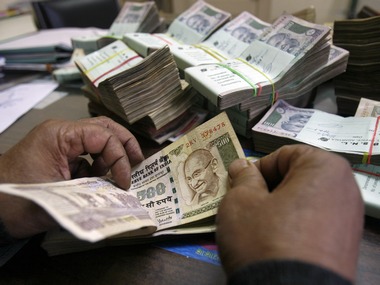The rupee, which had weakened to record lows against the dollar in August, should gain comfort from the strong euro as it signifies rising risk appetite in the market. The US Federal Reserve is still months away from tapering bond purchases given the debt ceiling issues. This should lend further strength to the euro. This will benefit the rupee, which should see better days ahead.
The euro has strengthened 14 percent against the dollar from lows seen in July 2012. The euro-dollar is now trading at two-year high levels of $1.379. The euro was almost written off at the peak of the Eurozone sovereign crisis that saw Greece restructuring its debt while bond yields of Spain and Italy rose to unsustainable levels of over 7 percent. Coordinated efforts by the EU (European Union), IMF and the ECB led by the Eurozone’s strongest economy, Germany, prevented a collapse of the euro and of the indebted sovereign nations.
[caption id=“attachment_1122419” align=“alignright” width=“380”]
 The rupee, which had weakened to record lows against the dollar in August, should gain comfort from the strong euro as it signifies rising risk appetite in the market. Reuters[/caption]
The rupee, which had weakened to record lows against the dollar in August, should gain comfort from the strong euro as it signifies rising risk appetite in the market. Reuters[/caption]
The EU and IMF together extended loans to the indebted nations while ECB bought bonds and infused funds through emergency funding scheme auctions to stem the run on the euro. ECB lowered interest rates to all-time lows of 0.5 percent to provide cheap liquidity to markets. The result of the actions by the ECB, EU and IMF is seen in the strength of the euro as well as the 250 bps fall in yields of Spanish and Italian bonds.
The fact that the euro has strengthened does not in any way suggest that the Eurozone economy is doing well. The unemployment levels are at record high and GDP growth was at 0.3 percent for the second quarter of 2013. The economy looks to be limping back from recession with growth being negative in the last few quarters but is still very far away from even moderate growth levels. Indicators such as manufacturing indices and job additions do point to higher economic activity but sustained recovery is still highly elusive.
On the other hand, the US economy is growing at around 2 percent levels, job additions have been positive on month for two years and unemployment rate has come off from highs of 10 percent seen in October 2009 to levels of 7.2 percent as of September 2013. However, despite the US economy’sperforming better than the eurozone, the dollar has depreciated against the euro over the last 14 months.
The interest rate differential between the Fed and ECB rate is just 0.25-0.5 percent. Spread between ten-year US treasury yield and ten-year German Bund yield (German Bund is the benchmark Eurozone bond) is 80 bps, which should be positive for the dollar. The Fed is pumping in $85 billion a month into the system through bond purchases while the ECB is ready to buy bonds in case of any market volatility. The case for the euro strengthening on growth or rate differentials with the dollar is just not apparent.
So why has the euro strengthened? The strengthening is largely due to markets covering short euro/ euro assets positions and due to risk appetite coming back to investors. Bond yields of Spain and Italy at around 4.1 percent to 4.2 percent levels offer a spread of 230 bps over the German Bund. Germany’s benchmark equity index the Dax, is trading at record high levels. Credit spreads as measured by CDS (Credit Default Swap) curves for Eurozone countries have come off sharply from highs over the last two years. Markets are funding the risk appetite with the dollar given the Fed’s easy money policy.
Arjun Parthasarathy is the Editor of www.investorsareidiots.com a web site for investors
Arjun Parthasarathy has spent 20 years in the financial markets, having worked with Indian and multinational organisations. His last job was as head of fixed income at a mutual fund. An MBA from the University of Hull, he has managed portfolios independently and is currently the editor of www.investorsareidiots.com </a>. The website is for investors who want to invest in the right financial products at the right time.
)